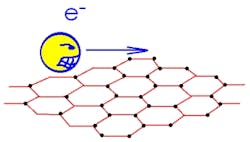Plasmonic nanostructures boost light-harvesting efficiency of graphene twentyfold
Manchester, England--Graphene, a monolayer form of carbon with properties that will likely mean great things for optics as well as electronics, will be giving high-speed optical communications a boost, if research at the Universities of Manchester and Cambridge pans out. A combination of graphene with metallic nanostructures appears to show a twentyfold enhancement in converting light to electricity when compared to graphene by itself.1 This could mean dramatically improved photodetectors for fiber optics, for one.
Much of the excitement over graphene is based on the unique nature of electron travel in graphene, in particular the high mobility and high velocity of electrons, which travel ballistically in graphene. The major stumbling block towards graphene-based devices has so far been their low efficiency; the problem is that graphene absorbs little light—somewhere around 3%—with the rest passing through without contributing to the harvested electrical power.
The plasmonic nanostructures developed by the Manchester and Cambridge boffins greatly enhance the optical electric field felt by graphene, effectively concentrating light within the one-atom-thick carbon layer. As a result, the light-harvesting performance of graphene was boosted by twenty times without sacrificing any of its speed. The future efficiency can be improved even further.
“Graphene seems a natural companion for plasmonics," says Alexander Grigorenko, one of the researchers. "We expected that plasmonic nanostructures could improve the efficiency of graphene-based devices, but it has come as a pleasant surprise that the improvements can be so dramatic.”
REFERENCE:
1. T. J. Echtermeyer et al., Nature Communications, http://arxiv.org/abs/1107.4176.
About the Author
John Wallace
Senior Technical Editor (1998-2022)
John Wallace was with Laser Focus World for nearly 25 years, retiring in late June 2022. He obtained a bachelor's degree in mechanical engineering and physics at Rutgers University and a master's in optical engineering at the University of Rochester. Before becoming an editor, John worked as an engineer at RCA, Exxon, Eastman Kodak, and GCA Corporation.

